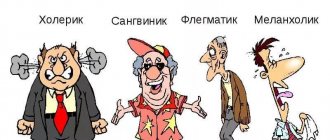What is temperament
Temperament is the foundation of personality: the very solid foundation on which actions, the direction of thought, views on various aspects of life and the structure of the individual as a whole are based.
Temperament determines how resilient a person’s psyche is, that is, what strength the processes of excitation and inhibition have, how balanced and fluid these processes are.
Discovery of temperament
The Soviet scientist-physiologist Ivan Petrovich Pavlov made a huge breakthrough in the development of psychology, developing a detailed description of possible options for the formation of conditioned reflexes. For example, if excitation dominates, reflexes form faster than they fade. If inhibition predominates, the opposite is true. Thus, it becomes clear that each person, depending on their innate characteristics, needs an individual approach, be it the process of education, training or correction.
Temperament and personality traits
Temperament is an innate concept that denotes the entire spectrum of mental properties and directly influences the formation of one’s personality. Criteria such as the speed of mental activity, its rhythm and tempo, intensity, stability and direction depend on the temperament inherent in the child by nature. In addition, it is he who determines how emotional and impulsive a growing person will be, as well as whether he will be characterized by anxiety, impressionability and dozens of other properties.
Temperament and character
Don't confuse character with temperament. If the first can change more than once under the influence of society, then the second is given once and for all, but if you wish, you can learn to manage it competently.
Temperament and activity
The individuality of the style of a particular activity is another merit of temperament. Two people can arrive at the same result in completely opposite ways: for example, one of them will get an A on an exam by copying from a neighbor, and the other will get an A on their own.
How does temperament differ from character?
Let us remember that these are two completely different concepts. Character is formed, consolidated or changed under the influence of the following factors:
- education depending on the family situation;
- systematic independent work on oneself (self-education, self-development);
- the degree of acceptance of certain norms provided by the environment;
- analysis of acquired life experience.
In order to change even slightly in character, it is not enough to meet one of the listed conditions: their combination is required.
It is impossible to radically influence temperament as a property of human nature given from birth. However, using the same conditions given above, you can take control of it. The main criterion will be the desire of the person himself, patience and perseverance: the necessary changes will not happen in one hour, a systematic approach is important here.
Properties of temperament
In fact, these are the data inherent in a person by nature, which affect the speed, stability and intensity of mental processes.
Sensitivity
This is the force of influence from the outside, necessary to launch processes in the psyche. Sensitivity also determines their speed.
Reactivity
Affects the intensity and speed of reaction to a sudden stimulus: a loud sound, a light suddenly turned on, an unexpected action on the part of another person, and so on. Reactivity determines how much an individual is able to concentrate or, conversely, be distracted from business.
Activity/passivity
How quickly a person can influence the circumstances that interfere with achieving a goal. Directly depends on reactivity: the ability at one time or another to concentrate on one’s desires, goals, motivation, beliefs, needs.
Plasticity/rigidity
This concept determines how quickly an individual is able to get used to new conditions. Plastic means perfectly adapted to change. Rigid - on the contrary, experiencing difficulties in changing point of view, any interests and opinions.
Extroversion/introversion
A popular term meaning focus on the external world around us (Latin extra - “outside”), or into one’s subjective inner world (Latin intro - “inner”). Extroverts are more focused on events occurring in the present, here and now. Introverts are more focused on images of the past or future.
Emotional excitement
The rate of activation of the nervous system in response to external stimuli. Here we mean the most minimal reasons that prompt a person to react emotionally to what is happening.
Rate of reactions
Another integral property of temperament, which lies in the speed of mental processes and the duration of a particular reaction. An example would be the speed at which a person talks, or how quickly he reacts to a ball flying towards him.
A scientific approach to the study of temperament
Modern psychology is actively studying what temperament is and how it affects behavior. Today, scientists share the influence of temperament on a person’s emotionality and activity, so traditional classifications have been improved. Such scientists as Carl Jung, Hans Eysenck, Boris Teplov and other famous scientists worked on the study of temperaments.
The Russian scientist Ivan Pavlov made a great contribution to the study of temperaments. He proved that the higher nervous activity of animals and humans is structured in the same way, therefore types of temperament are also present in animals (they are most pronounced in mammals). Boris Teplov did a lot of work on studying the dynamic features of higher nervous activity. He studied the rate of emergence, progression and cessation of mental processes.
Carl Jung introduced the concepts of introvert and extrovert, reflecting a person’s inclination and ability for interpersonal communication. He paid attention to the dependence of temperament on feelings, thinking, sensations and intuition. In the alternative classification proposed by Jung, 8 personality psychotypes are presented.
Hans Eysenck collected all available information and created a new technique for fairly accurately determining temperament. It remains relevant, providing good accuracy today, due to which it is actively used in modern psychology under the name “Eysenck Temperament Test”.
Four types of temperament
The ancient Greek physician Hippocrates believed that the temperament of a person is determined by one of the so-called “body juices”: black bile, yellow bile, blood or phlegm (lymph).
Classification according to the processes of excitation and inhibition
Based on ancient teachings, several types of classifications of temperament appeared in psychology. All of them distinguish 4 types of temperament: choleric, sanguine, phlegmatic and melancholic.
Sanguine
Active, enterprising, fairly balanced. The sanguine type is characterized by rapid processes of excitation and inhibition.
- Cheerful, active, sociable, responsive, successful in many areas of life.
- Rarely worries about failures or gets upset over trifles, tends to be a leader, and easily gets used to new conditions.
- Multitasking: Easily switches from one task to another.
- He needs a constant influx of impressions, otherwise he gets bored.
- Emotions replace each other quite quickly and are therefore unstable. Nevertheless, the sanguine person knows how to competently manage them.
- Resourceful, inventive.
- He is characterized by a loud, sincere laugh, fast speech and agile facial expressions.
Phlegmatic person
He is characterized by little activity, mostly inactivity, and balance. Conditioned reflexes are very stable, but they form rather slowly.
- Overly cautious, judicious, rather passive. It can be tedious and boring.
- Friendly, peace-loving, reliable comrade.
- Inclined more towards conservatism than change.
- Restrained, cold-blooded, sometimes too much.
- Such a person is easy to manipulate.
Choleric
Impulsive, hot, active, not very balanced type. The braking speed is much weaker than the excitation process.
- Calmness is definitely not his thing: choleric people are prone to mood swings and even aggression.
- Extremely fickle, impulsive, optimistic.
- He has gorgeous facial expressions, active gestures and fast speech.
- He can be loud, impatient, and often completely unable to cope with his own emotions.
Melancholic
It can be both mobile and vice versa. At the same time, weak, unbalanced, apathetic.
- Prone to constant anxiety and bad mood, even if there is no reason for it.
- Emotional, sensitive, easily hurt.
- Provides extremely weak resistance to external stimuli.
- Self-doubt, timidity, and touchiness are constant companions of a melancholic person.
- He speaks quietly, without obvious facial expressions or gestures.
- Poorly adapts to new conditions.
Typology of Claudius Galen
Taking the teachings of Hippocrates as a basis, Claudius Galen, an equally significant figure in ancient medicine, invented the familiar typology of temperaments, according to which:
- the predominance of blood makes a person sanguine (mobility, cheerfulness);
- the predominance of lymph is characteristic of a phlegmatic person (slowness, calmness);
- yellow bile means that the individual is choleric (impulsiveness, the ability to do something rashly);
- black bile is melancholic (pessimistic, sad, wary).
Sanguine
In most cases, he lives by emotions. Can perform some action in the heat of the moment, but then quickly cool down. Very naive, inclined to trust others. Strives to enjoy life and everything he does.
Choleric
Hot, ardent, passionate type. Remembers both positive events and bad ones well. He is characterized by rancor, vindictiveness, inflated pride and narcissism.
Phlegmatic person
Outwardly quite neutral, not inclined to extremes. It is difficult to anger such a person: he rarely falls under the influence of his own emotions.
Melancholic
Sad, passive, pessimistic, he will find a reason to be sad under any circumstances. It is characterized by very one-sided extremes: if a negative event in life is a local end of the world, if there is a small reason for frustration, then suffering on a universal scale. Any achievement seems to him to be a path through pain. Often complains of loneliness. It is very easy to offend such a person with a word.
Signal system proportions
The signaling system is all existing mental processes that are responsible for the perception of information coming from the outside, its analysis, conclusions and appropriate reaction. There are two types:
- the first signaling system means the assimilation of received information (processes occurring in the cerebral cortex);
- the second signaling system is everything related to the ability to speak.
If we consider their relationship, we can recognize three types of people. This classification, however, is considered very relative and directly depends on the particular activity that a person encounters.
Artist
The first signaling system predominates in him.
Thinker
It is characterized by the predominance of the second signaling system.
Mixed type
Approximately equal ratio of both types of systems.
Constitutional theory of Ernst Kretschmer
This typology was created by psychologist and psychiatrist Ernst Kretschmer based on the discovery of stable connections between a variety of temperament and an individual’s innate physique. In simple words, people with certain differences in the constitution of the body have corresponding features of the structure of the psyche.
A preliminary assessment of body structure often helps to establish contact from the first minutes of communication.
Asthenic type (schizothymic)
Absolutely weak-willed, withdrawn, focused on his inner world. Prone to sudden mood swings. On the one hand, he is an intelligent dreamer, on the other, he is a stubborn egoist and abstract dreamer.
Pyknic type (cyclothymic)
He is either at the very top of the emotional wave, or sharply goes to the bottom. Being cheerful, positive and very talkative, he easily gets used to any company, becoming an ideal interlocutor.
Athletic type (ixothymic)
It's hard to surprise him with anything. Calm, reserved, not generous with gestures and facial expressions. It costs him enormous effort to adapt to new conditions. Doesn't have flexible thinking.
Melancholic people
Melancholic people are completely immersed in their own inner world. They are rarely interested in what is happening around them; it is much more interesting to think about lofty matters. Melancholic people are periodically overcome by causeless sadness, and anxiety literally follows on their heels. An abundance of restless thoughts and experiences often results in creativity. Therefore, they make talented writers, artists and musicians.
People with any type of temperament have strengths and weaknesses. The first ones should be encouraged and developed, but the rest can be fought. For example, you can get rid of chronic fatigue and live in a good mood!
Definition of temperament and brief instructions for interaction
To determine a person’s temperament from the outside, as well as for self-diagnosis, many methods have been created that show the most accurate result.
- Hans Jurgen Eysenck's questionnaire contains one hundred questions and only two possible answers: yes or no. The test is also notable for the fact that it can be used to recognize a mixed type.
- The method of Nikolai Nikolaevich Obozov is a scale on which you need to select the degree of manifestation of a particular property.
- Diagnostics according to Vladimir Rusalov is in many ways similar to Eysenck’s psychological test, but there are a little more questions - 105. They need to be answered quickly, without going into long thoughts.
- Jan Strelyau's method for diagnosing temperament is intended for adults, as it is replete with terms that teenagers and children have not yet encountered. The test is aimed at assessing three parameters: excitation, inhibition, and the dynamism of mental processes.
- Questionnaire B.N. Smirnova requires the most truthful, sincere answer to each point and allows you to determine the type of reaction, activity, as well as the very sincerity with which the person answered the questions.
- Alexander Belov's formula is based on the concept of mixed types. The test is carried out using four cards on which 20 expressions are presented. Each block corresponds to one or another type of temperament.
It is worth remembering that determining temperament is the first, but not the last step in interacting with a person. The most important thing is to learn to find the right approach to a particular type.
Interaction with a sanguine person
- He cannot live without communication, which is why he always makes a wide circle of acquaintances. Attracts people like a magnet.
- Has his own “cockroaches in his head.” Not being very prone to quarrels, he can sometimes display a similar quality.
- Often makes incorrect conclusions, thinking too quickly and superficially. This trait is inherent in him by nature; you just need to humble yourself and present the information correctly.
- Don't expect a sanguine person to admit a mistake on his own.
- This is the person whose facial expressions speak for themselves: its dynamics reveal true emotions and attitude to what is happening.
- He needs a constant influx of new impressions, and the brighter they are, the happier the sanguine person will feel. If you don't want such a person to leave you, don't let him get bored.
- Loves to give advice and express his opinion.
- He likes to make joint plans, share leisure and responsibilities with someone.
- Extreme and adrenaline are another “air” that a sanguine person breathes.
Interaction with a choleric person
- The speech of a choleric person often precedes his own thoughts.
- Subject to the emotions that he experiences here and now. Don't be surprised if a couple of hours later he gives you the opposite opinion on the same situation.
- In the wake of a surge of anger, he can say unpleasant things, but this does not mean at all that he seriously thinks so. Let the choleric person calm down.
- Do not take all his words or actions to heart, be lenient, avoid conflict situations.
- Try not to return to a discussion of an incident that is not relevant at the moment: choleric people quickly forget what happened.
- You should not put pressure on him, especially with a sense of duty.
- The choleric person needs your support, although he may not show it.
Interaction with a phlegmatic person
- Information from such a person sometimes has to be extracted with pincers.
- A phlegmatic person will never show flexibility in relation to new circumstances: let him get used to them, do not demand that he do it faster.
- Be patient and forgiving: this is still a conservative.
- Instant emotional response and sympathy are not his thing.
- This is a man not of words, but of actions: he may not show or say that he worries about you, but he will definitely do something useful.
- He will expect exactly the same approach from those around him: he doesn’t need words.
- A phlegmatic person is a person of strict logic and prudence. If you want to win his attention and trust, reason in a similar way, avoiding fantasies and abstract statements.
- Figurative expressions and youth slang will be unpleasant for a phlegmatic person. Talk to him clearly, in simple and understandable language.
- Information is best perceived in written form.
Interaction with a melancholic person
- A melancholic person approaches contact with new people carefully and gradually. Do not demand from him speed in this matter.
- Speak calmly, avoiding loud speech and sharp accents on words.
- Do not evaluate from a negative side what a melancholic person values. Avoid categorical judgments and criticism in his direction. Veil all this with the softest phrases possible.
- To get closer to such a person, it is enough to tell some sad story from your life. Melancholic people love heart-to-heart conversations.
- They won't like extreme sports at all. The same goes for horror films and various action films.
- A melancholic person should not be driven into strict deadlines, otherwise he will be overtaken by stupor.
- If an activity requires scrupulousness, attention and careful elaboration of details, a melancholic person will cope with it perfectly.
- Such people have highly developed intuition.
The influence of temperament on human life
Temperament largely determines certain aspects of an individual's life. Eg:
- shaping his environment;
- quality of life, feeling of internal and external comfort;
- the ability to withstand difficulties and adapt to new conditions;
- achievements and losses;
- perception of what is happening;
- susceptibility to emotions when making important decisions or a cool-blooded analysis of possible consequences and much more.
Who is a temperamental person?
It is believed that such a phrase is an incorrect use of the term “temperament”, since each person has his own and there is no universal characteristic. In the usual understanding, what a temperamental person is is someone who has clearly expressed emotions, who are decisive and proud. This definition is not directly related to the topic of the article.
The power of education, childhood trauma
Various psychological traumas received in childhood undoubtedly influence the formation of personality, but this mostly relates to the character of the individual. Temperament can help to withstand pressure, injustice, misunderstandings and other situations that often occur at the instigation of parents, relatives or teachers. A different type of temperament, on the contrary, forces you to cave in, resign yourself, or fall into deep depression and hatred of the world.
Borderline states with pronounced temperament
When neurochemical systems are extremely imbalanced, temperament types manifest as psychiatric profiles.
| Temperament type | Borderline state | Symptoms |
| Choleric | Impulsive personality disorder | Uncontrolled attacks of anger, short temper, inciting quarrels and conflicts over nonsense. |
| Phlegmatic person | Schizoid personality disorder | Withdrawal, escape from reality, isolation, and then complete closure. |
| Sanguine | Hypomania | Cheerful mood, denial of problems, energy, feeling of complete well-being, euphoria. |
| Melancholic | Anxious personality disorder | Extreme vulnerability, inferiority complex, constant fear. |










